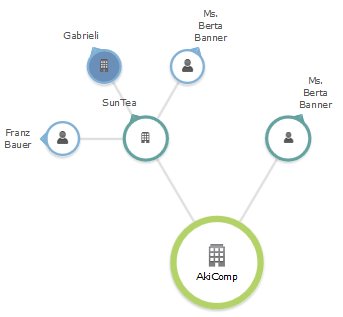Relationships
Learn how to depict hierarchies and networks between companies and persons using Relationships.
You can store relationships between companies and persons (e.g. parent and subsidiary companies, sales partners, suppliers, competitors) and display the resulting networks.
Adding Relationships
To add a new relationship:
- Select New > New relationship from the company or person’s context menu. The system guides you through the process of adding the new relationship.
- Choose whether you want to add a relationship with a company or a person.
- Select the record you want to add the relationship with. You can also choose to add
a new record; to do so, click on
 (New) in the header of the search
results.
(New) in the header of the search
results. - Determine whether a reciprocal relationship should be added.Note: When adding a new relationship, the Create reciprocal relationship check box is enabled by default in Aurea CRM web. If the type of relationship you are adding is between two companies and of the type "Parent", the reciprocal relationship is "Subsidiary" (i.e. one company is the parent company and the other is the parent’s subsidiary). The type of reciprocal relationship is displayed for each relationship in the Reciprocal Rel. Type column. Your administrator can change the default behavior of this check box.
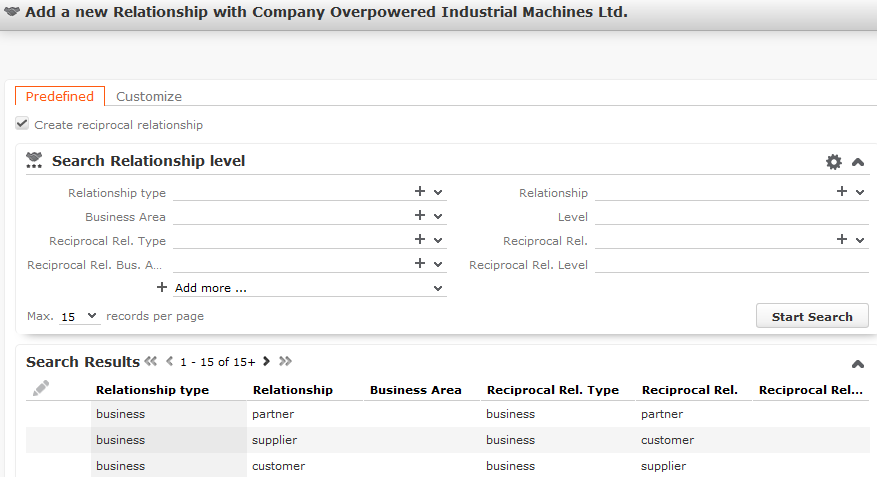
- Select an existing relationship on the Predefined tab of
switch to the Customize tab to define a new relationship.

- Enter the Type of relationship, the Relationship and the Business Area. The first row defines the relationship, the second row defines the reciprocal relationship.
- Click on Continue to add the relationship.
Searching for, Editing and Deleting Relationships
To search for and edit a relationship:
- Select Go to All Related > All
Relationships from a company or person’s context menu.
The Search Relationships linked to [name] page is opened. Click on Start Search. The results of the search are displayed.

- Enable the Company-Related option to prevent person-related relationships from being displayed (i.e. to only display relationship between two companies).
- You can edit relationships as follows:
- Double-click on a record in the list or select Edit from the record’s context menu.
- Select Delete from the context menu to delete the relationship. A message is displayed and you can determine whether only the relationship should be deleted, or whether the reciprocal relationship should also be deleted.
Relationship Hierarchy
The relationship hierarchy provides a graphical overview of all companies and persons that are directly or indirectly linked to other companies or persons.
To display the relationship hierarchy:
- Select Relationship Hierarchy from the desired company or
person’s context menu. A hierarchical overview of the relationships is displayed.
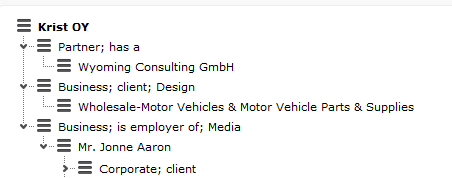
The company you opened the relationship hierarchy from is displayed in bold.
- Click on an entry to display the related record’s data below the hierarchy.
- Click on
 (Show Menu) next to an entry in
the hierarchy and select Tab View from the context menu.
(Show Menu) next to an entry in
the hierarchy and select Tab View from the context menu.
Cyclical Relationships
If cyclical relationships exist (e.g. A is partner of B; B is a partner of C; C is a partner of A), one of the companies/persons needs to be displayed more than once. One occurrence is defined as the main record and the other as duplicates. Duplicates are indicated using an *.
No further relationships are displayed for duplicates. All relationships are displayed for the main record, except for with the company/person directly above the main record in the tree. This includes relationships to companies that are in turn linked to duplicates of this company/person. This allows you to display all relationships for this company/person at a single point in the tree.
Relationship Network
The relationship network displays all a company or person’s relationships with other companies and persons.
Multiple levels can be displayed in the relationship network. Each level represents a degree of separation from the current record (i.e. the first level corresponds to those companies/persons directly linked to the current record, the second level corresponds to those companies/persons linked to the companies/persons in the first level etc.).
To display the relationship network:
- Switch to the desired company or person.
- Select Relationship Network from the context menu. The
relationship network is displayed.
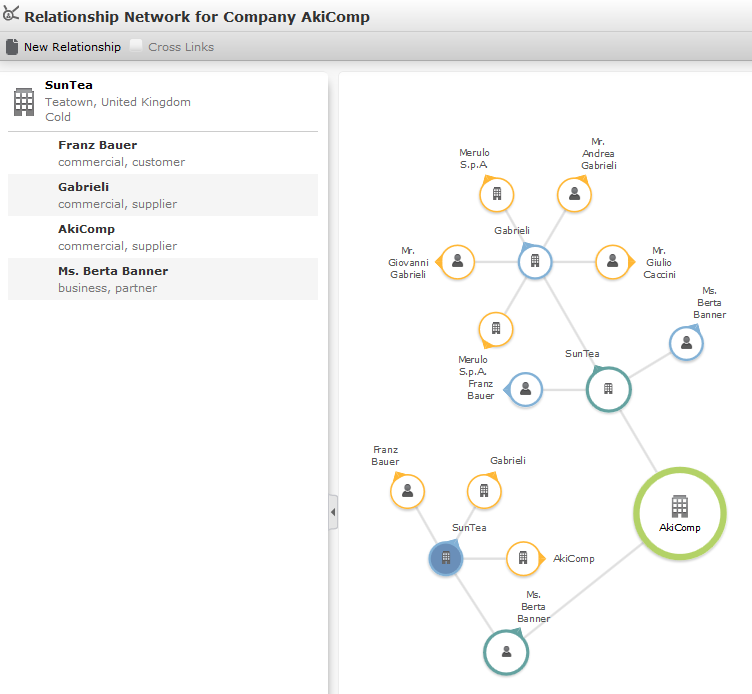
- The current record (company or person) is displayed at the center (large node with a green border). All records that are linked to the current record via a relationship are displayed surrounding the current record. Reciprocal relationships are not displayed.
- Move the mouse cursor over a connecting line to display the type of relationship.
- Click on
 on the left to open the side bar containing a list of the
relationships stored for the current record (note that any predefined filters are
also applied to this list). Open the context menu for an entry in the list and select
the person or company’s name to display the company or person in the quick view.
Click on
on the left to open the side bar containing a list of the
relationships stored for the current record (note that any predefined filters are
also applied to this list). Open the context menu for an entry in the list and select
the person or company’s name to display the company or person in the quick view.
Click on  to close the side bar.
to close the side bar. - Click on a node in the tree to select that company or person. The list of relationships on the left is updated to display the relationships defined for the selected company or person.
- Double-click on a node to open the corresponding record.
- Click again on a selected node to hide or display all relationships defined with that company or person. The nodes are color-coded according to their level in the network (i.e. how many degrees of separation lie between the node and the current record).
- Select a node and click on
 New Relationship to add a new relationship for the selected
company or person. The relationship tree is refreshed once the relationship has been
added.
New Relationship to add a new relationship for the selected
company or person. The relationship tree is refreshed once the relationship has been
added. - Click on a node and hold down the mouse button to open the company or person in the quick view. You can access the record’s context menu from the quick view.
- Use your mouse wheel to zoom.
- You can scroll the view and reposition nodes in the network:
- Click anywhere in the network where the
 mouse
cursor is displayed to scroll in the network.
mouse
cursor is displayed to scroll in the network. - Click on a node and then click on it again while holding down
the mouse button (the mouse cursor is displayed as
 ) to
move the node. Any child nodes are also moved.
) to
move the node. Any child nodes are also moved.
- Click anywhere in the network where the
- If the current record has relationships with more than 10 records
(by default), the
 and
and  nodes are displayed. Click on these nodes to display
additional records that relationships have been defined with.
nodes are displayed. Click on these nodes to display
additional records that relationships have been defined with. - Enable the Cross Links option to prevent the same record
being displayed multiple times in multiple nodes (when more than one company or
person is related to the same company/person). Each company/person is only displayed
once and a dotted line indicates the additional relationships with a node.
Example: If a relationship is defined between a person and two companies in the network, the person is displayed twice, once per relationship with each company. If the Cross Links option is enabled, the person is only displayed once and a dotted line links the second company to the person.
|
|
|
Defining Relationship Levels
The relationships that are available for selection are defined in the Relationship Level info area.
To add a relationship level record:
- Select
 (Administration) > Relationship
Levels.
(Administration) > Relationship
Levels. - Click on Start Search and then on
 (New).
(New). - Define the Relationship type, Relationship and Business Area for both the relationship and the reciprocal relationship, and enter the appropriate Level.
- Save the record. The defined relationship can then be selected when defining relationships.
The Level field is used to determine the hierarchical structure formed by the relationship and which company is the root of the hierarchy:
- For all relationships that are not part of a hierarchy (i.e. partnerships), the field should remain empty.
- For those relationships defined at the top of the hierarchy, the value is 1; the value for the reciprocal relationships is 2 in this case.
For each further level, the value of the upper level is always 1 lower than the level below. i.e. for the second level (the one below the parent), the Level is 3 for the relationship and 4 for the reciprocal relationship.
Enable the Relationship hierarchy field if the relationship level record defines a relationship used to define a corporate structure. The following criteria need to be met:
- A reciprocal relationship must exist.
- The Level field in the record must contain a value that is higher or equal to the level in the reciprocal relationship.
- The same value must be entered in the Relationship type and Reciprocal Rel. Type fields.
Corporate Structure
The corporate structure can include hierarchical relationships and relationships on the same level. The corporate structure can be used to define access rights and to display corporate hierarchies, see Conditional Access to Info Areas in the CRM.core Administrator Guide.
Companies and persons may be present in more than one corporate structure; for example, a company may be part of a corporate group in one structure and a supplier in another.
The corporate structure can be used to grant access to child records of companies and persons (nodes in the example trees below), e.g.:
- Child records stored for records directly above the current node in the corporate
structure all the way to the root node.
In this case, you can display all child data stored for parent companies linked to the current company using corporate structure relationships. These are the companies entered in the relationship records with a lower relationship level than the current company.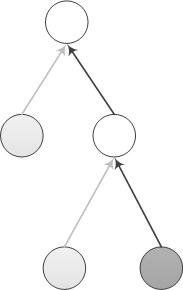
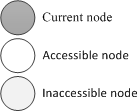
- Child records stored for records directly below the current node in the hierarchy.
In this case, you can display all child data stored for child companies linked to the current company using corporate structure relationships. These are the companies entered in the relationship records with a higher relationship level than the current company.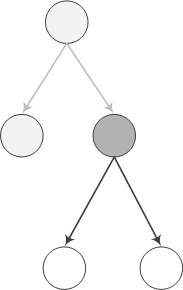
Relationship records are used to store the type of relationship between a source company/person and a target company/person. The hierarchy itself is defined in the relationship records using the station and serial numbers of relationship records (not company/person records). The keys of relationships higher up in the hierarchy and of the current relationship are automatically entered in the PB_1_StaNo/SerNo - PB_10_StaNo/SerNo fields in one of the relationship records (if applicable, the one with a lower level). These fields depict the path from the current relationship record to the root relationship record; the root relationship’s key is always entered in the PB_1_StaNo/SerNo fields. The root relationship itself thus only contains a link to itself in the PB_1_StaNo/SerNo fields, and the Generated check box is enabled for this relationship. This relationship record is added automatically.
To define the corporate structure, suitable relationships first need to be defined in the Relationship Level info area. The Relationship type and Reciprocal Rel. Type must both be the same and the Relationship hierarchy field needs to be enabled in the child relationship level record (i.e. the relationship with a higher Level). In the case of relationships on the same level, the check box should only be enabled in one of the relationship level records.

Whenever new relationships are added using the relationship defined in the relationship level record, links to the relationship records corresponding to nodes higher up in the corporate hierarchy are entered in the PB_1_StaNo/SerNo-PB_10_StaNo/SerNo fields in the child relationship (i.e. the relationship corresponding to the relationship level record where the Relationship hierarchy check box is enabled). The corporate hierarchy can consist of up to 10 levels.
Example: The corporate structure is defined for five companies. Company 1 is at the root level, Company 2 is defined as a subsidiary of Company 1, Company 3 as a subsidiary of Company 2 etc. all the way down to Company 5 at the bottom of the hierarchy. The corporate structure above the current relationship is entered in the relationship records added for the "is a subsidiary of" relationship (Company 2 is a subsidiary of Company 1, Company 3 is a subsidiary of Company 2 etc.).
The "is a subsidiary" relationship added for Company 5 (located at the bottom of the hierarchy) contains links to all "is a subsidiary" relationships in the hierarchy in the PB_X_StaNo/SerNo fields. PB_5_StaNo/SerNo contain the station number and serial number of the "is a subsidiary" relationship added for Company 5 (Company 5 is a subsidiary of Company 4); PB_4_StaNo/SerNo contain the station number and serial number of the "is a subsidiary" relationship for Company 4 (Company 4 is a subsidiary of Company 3) etc.
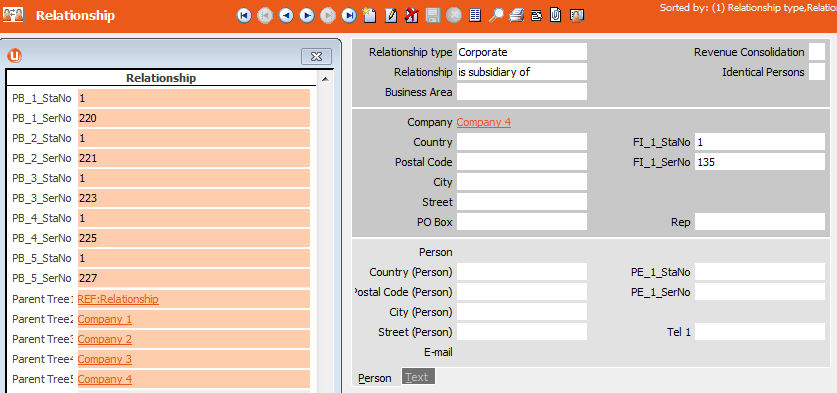
If you make changes to the records in the Relationship Level info area, including enabling the Relationship hierarchy check box, you can update the corporate structure automatically. If you disabled the Relationship hierarchy check box in a relationship level record used by the corporate structure and update the corporate structure, the entries in the PB_1_StaNo/SerNo-PB_10_StaNo/SerNo fields are deleted. If you delete a node (relationship record) in the corporate hierarchy that has child nodes, the child nodes immediately below the deleted records become the root nodes of new corporate hierarchies.
To update the corporate structure automatically:
- Aurea CRM win: Select Generate Relationship Hierarchy from the context menu in the Relationship Level info area.
- Aurea CRM web: Use a CRM.server To-Do (type 9), see To-Do Types in the CRM.core Administrator Guide.
Note: The PB_X_StaNo/SerNo fields are not communicated and are recalculated when inputting the communication file. The same applies when importing records. By default, updating the corporate structure does not initiate any triggers defined for the Relationship info area and the records’ time stamps are not updated. The corporate structure can be displayed graphically in a relationship network, see HierarchicalCircleOfInfluence in the Aurea CRM web Administrator Guide.OTC with Aurea CRM LSI
If you migrate an existing OTC installation to Aurea CRM LSI, the business logic of the Relationship and Relationship type fields in the Relationship level and Relationship info areas are reversed.
Corporate Structure Links
Aurea CRM offers indirect links (via the Relationship info area) that can be used to defined queries applied to the corporate structure, for example.
Links 950-980 and 30000-36000 are available by default and apply to all relationships used to define corporate structures (irrespective of the type of relationship), see Link IDs in the CRM.core Administrator Guide.
Indirect links (using the corporate structure) for companies and persons (FI/KP/PE/CP) applied to their child info areas:
- 30000: Returns the entire corporate structure
- 32000: Returns all companies and persons higher up in the hierarchy
- 34000: Returns all companies and persons lower down in the hierarchy
- 36000: Returns all companies and persons both higher up and lower down in the hierarchy
The following image outlines the difference between links 30000 and 36000. This also applies to the 950 and 980 indirect links.
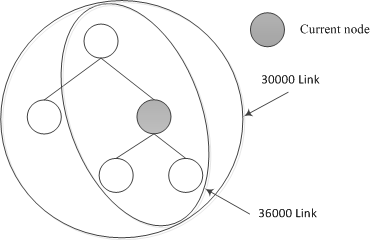
Example: The corporate structure is defined for five companies. The current rep is entered in the Rep 1 field of Company 2 (C2). An offer exists for each company.

Define a query that returns all offers stored for companies where the current rep is entered (in this case Company 2), as well as all offers stored for companies that are linked to companies where the rep is entered via the corporate structure.
Link 32000 returns the offers for companies 1, 2 and 5.
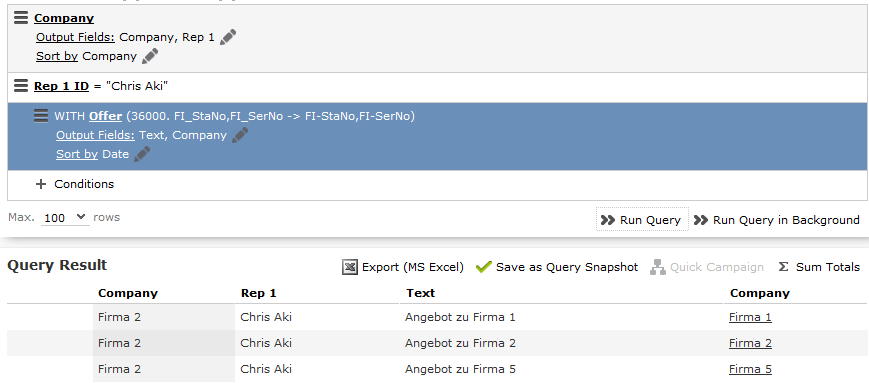
Link 34000 returns all offers for companies 2 and 5; link 30000 returns the offers for all companies and link 36000 returns the offers for companies 1, 2 and 5.
You can define variables of the Type "Condition" to define additional links using your own condition. You can define up to 10 different conditions for corporate structures using the 30000-130000 links. These links are numbered in intervals of 10,000 and are named (in Aurea CRM win) according to the relationship type (e.g. supplier, corporate).
You can define the following 10 variables:
(this variable further restricts the default links 30000-36000)CORE::INDIRECT-PB-LINK-TREE-0CORE::INDIRECT-PB-LINK-TREE-1...CORE::INDIRECT-PB-LINK-TREE-9Example: Define the variable
in Aurea CRM win. Select the Relationship info area in the Info Area field, the Relationship type field in the Field Name field and "Condition" in the Type field. Add a variable value for the variable and enter the comparison field and desired relationship type in the Var. Text field, e.g. "Corporate".CORE::INDIRECT-PB-LINK-TREE-1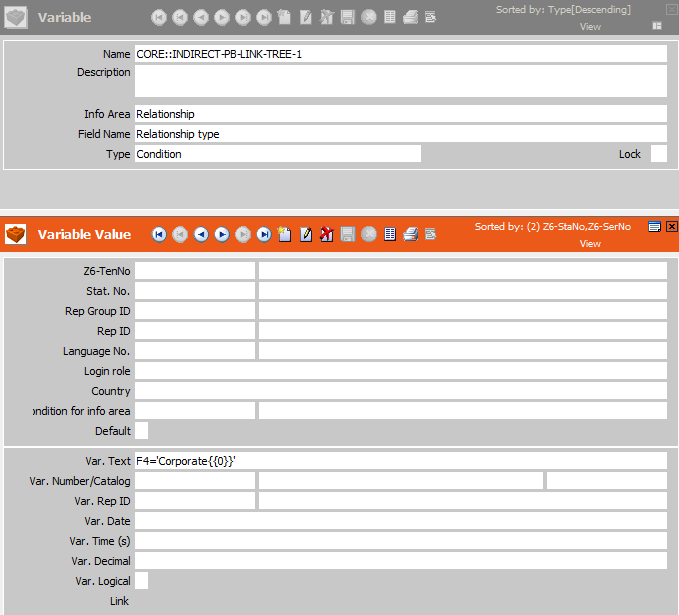
If you define conditional access rights for the Company info area in the Right module in Aurea CRM win and apply conditions to the Company info area, you can select the default indirect links and the links that only apply to the relationship type used to define the corporate structure in the Index Relationship column.
For example, this allows you to determine that a rep can access all Dutch companies as well as any subsidiaries of those Dutch companies where a corporate relationship has been defined.
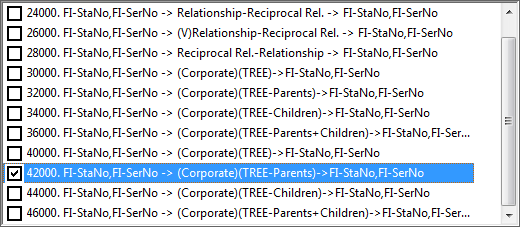 Note: For more information on variables, see Variables in the CRM.core Administrator Guide. You can also use indirect to define conditional access to companies and persons’ child info areas, see Conditions Applied via Indirect Links in the CRM.core Administrator Guide.
Note: For more information on variables, see Variables in the CRM.core Administrator Guide. You can also use indirect to define conditional access to companies and persons’ child info areas, see Conditions Applied via Indirect Links in the CRM.core Administrator Guide.
